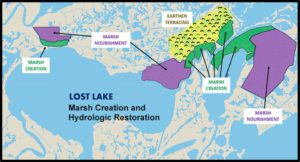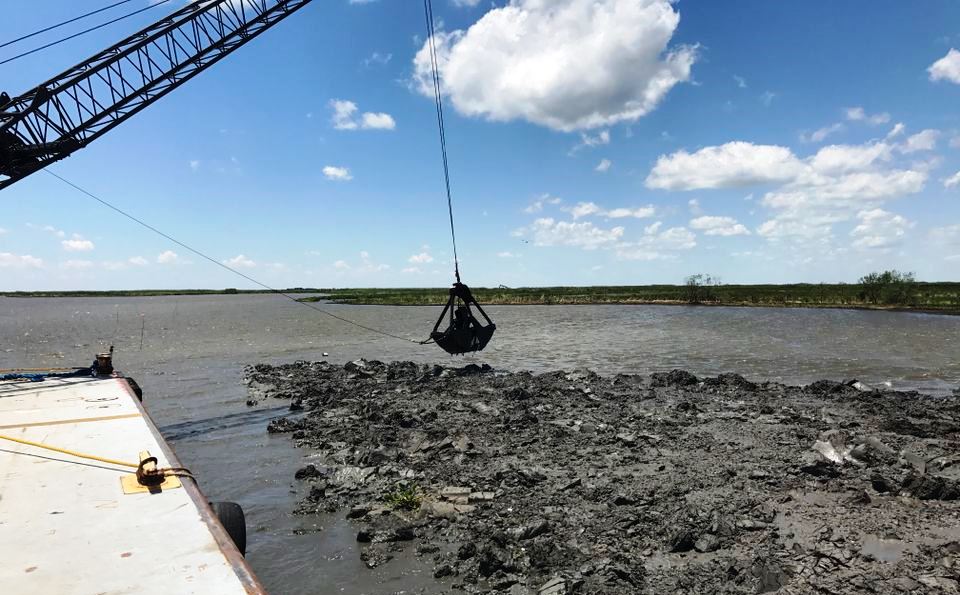On January 4, 2018, the completion of a $36 million project to restore and nourish wetlands on the northern edges of Lost Lake in Louisiana‘s Terrebonne Parish was announced by Governor John Bel Edwards.
“From the time I took office, coastal protection and restoration has been a priority for my administration, and this is what progress looks like,” Edwards said. “We’re looking forward to several coastal restoration projects that are slated to get underway this year, all of which will benefit our communities and our people in both the long and short terms.”

Various aspects of the Lost Lake Marsh Creation project. Image courtesy of the Coastal Protection and Restoration Authority.
Weeks Marine Inc.—based in New Jersey, but with several locations in Louisiana—was in charge of the dredging operation, which used sediment from the lake interior to build new wetlands in some open water locations, construct wetland terraces that block waves and surge and collect sediment in other locations, and to spray sediment atop some wetlands as nourishment.
The project also included construction of five water control structures along Bayous Carencro and Rice. In all, the project is estimated to benefit 1,158 acres in the south central part of the parish.
The project was built under the federal-state Coastal Wetlands Planning, Protection and Restoration Act (CWPPRA) program, which underwrites small and moderate size restoration project.
“It was clear we needed to take action in an area of high loss,” said interim CPRA Chairman Chip Kline. “And to benefit an area the size of 178 Superdomes in partnership with the Coastal Wetlands Planning, Protection and Restoration Act , U.S. Fish and Wildlife Service, La. Dept. of Natural Resources, and La. Oil Spill Coordinator’s Office is a good way to kick off a new year.”
The state is required to cover 15 percent of the cost, but state officials said a part of that cost share was in the form of state services, rather than money. The Louisiana Department of Natural Resources provided $1.8 million of the cost, and the Louisiana Oil Spill Control Office added $972,000 from revenue it collected as mitigation for oil spills. The federal sponsor of the project is the U.S. Fish & Wildlife Service.
The 30,000 linear feet of earthen terraces cover 22 acres north of Bayou DeCade, and are designed to break up wave energy to lessen erosion, adding protection to wetlands farther inland, and adding habitat for fish and wildlife, state officials said. The variable and fix-crested weirs that make up the water control structures will help maintain areas that have been either fresher or more salty in the past. The weirs can be adjusted according to seasonal or other conditions.
“Lake Pagie and Bayou Decade were essentially merging and indistinguishable because of marsh loss,” explained CPRA project manager Kenneth Bahlinger. “Also, northeast of Lost Lake, the marsh had deteriorated into large areas of open water where wind and wave energy were causing even more marsh breakup. Add to that the damage caused by higher salinity water held in these areas during storm events. It was imperative we take action to regulate proper seasonal balances of fresh and salt water.”
Terrebonne Parish President Gordon Dove said the project will work well with other restoration efforts recently completed in the same area. “Combined with the earlier CPRA North Lake Mechant Land Bridge project, Lost Lake’s 1,100 acre restoration will have a huge effect in controlling high salinity and water levels,” Dove concluded. “That means a lot to Terrebonne Parish and its people.”
Featured photo (courtesy of the Coastal Protection and Restoration Authority) shows a bucket dredge moving sediment into place to restore marshland along the edge of Lost Lake.

